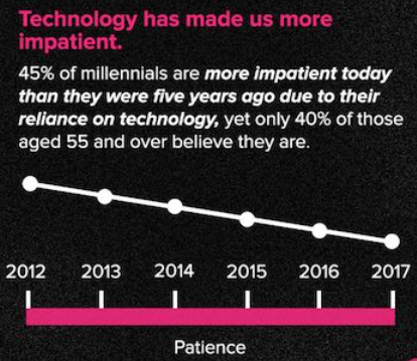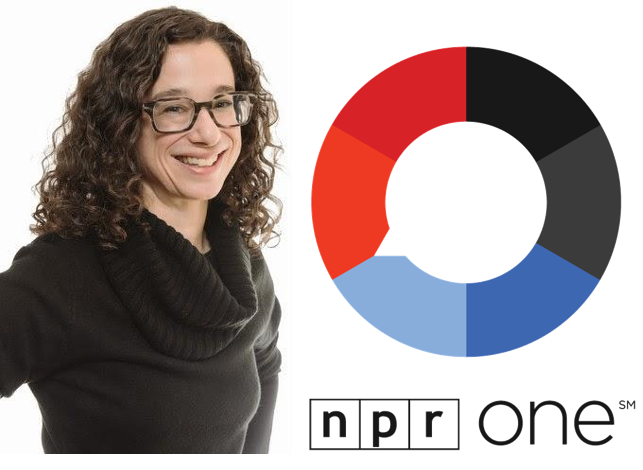
To perhaps no one’s surprise, we are getting more and more impatient. And technology is largely to blame.
Now a new study from Fetch and YouGov provides us with some evidence. Their web survey, conducted among 2,489 U.S. adults this past May, confirms that four of every ten Americans say technology has made them more impatient. You won’t be surprised to learn that Millennials are even more antsy than other generations.
And impatience impacts many aspects of daily life, from how long we’re willing to wait for takeout food or for an Uber to show up.
Of course, this has implications on media content and distribution. When consumers are more focused on instant gratification, it affects the gadgets they use and the content they consume. If a morning show bit is slow to develop, an app won’t open, or a video is too long, chances are they won’t wait around – or even try again.
The study indicates that frustration levels especially rise when consumers are confronted with automated responders (“Press 1 for to make a reservation…”) rather than a human, clunky search, and bad ads. In the radio world, we know all about that last one. And not surprisingly, commercials are always at the top of listeners’ lists of radio negatives.
The entire Fetch/YouGov infographic is here.
A deeper look at this impatience and how it impacts the radio programming side of the ledger conjures up some of the information that NPR has been disseminating since they began studying data from their NPR One app. That’s the mobile application that functions much like Pandora for public radio programming – curating skippable content so consumers can seamlessly move from one podcast or news story to another.
In the process of studying the metrics that move this app, NPR One leaders like Tamar Charney have made important connections about how content can be shaped to work around growing impatience levels.
 Today, Tamar is Managing Editor of NPR One, but for many years, she sweated the programming details at Michigan Radio, the state’s leading public radio station. Earlier in the year, she wrote an article for podcasters – “How To Hook Your Podcast Audience” – that has applications for program content of all shapes and sizes.
Today, Tamar is Managing Editor of NPR One, but for many years, she sweated the programming details at Michigan Radio, the state’s leading public radio station. Earlier in the year, she wrote an article for podcasters – “How To Hook Your Podcast Audience” – that has applications for program content of all shapes and sizes.
Here are some of Tamar’s guidelines (with commentary from me):
1. Start strong
Since the advent of PPM, this has been a consultant mantra. And for good reason.
Consumers make decisions early on about whether they’re going to stay around for a song or a morning show bit. You can’t control how 21 Pilots or the Stones recorded their songs, but you can manage breaks, podcasts, videos, and other content to ensure they quickly and efficiently draw listeners in – and very quickly get to the point. Rambling opens, long setups, and unfocused bits are the surest way to trying audience patience.
2. Re-engage the audience
For podcasts, Tamar suggests resetting a podcast every 2-5 minutes. That’s a good rule of thumb for a morning show bit or interview, especially as listeners are coming and going during the course of a segment or a bit.
3. Don’t save the best for last
Tamar reminds podcasters that the audience is biggest at the beginning and smallest at the end. So holding back on a powerful climax, a great question, or a big laugh line might be working against the patience levels of your audience.
4. Watch your data
In the world of podcasts, Apple will later this year start providing more granular metrics about who stays on who goes. Radio programmers have ratings data that provide general answers about audience engagement through stats like time spent listening. While this data isn’t especially detailed, it does offer guidelines about how well stations and shows engage audiences.
Following these basics can push back against the growing impatience levels of your audience, especially if you’re targeting the younger end of the spectrum.
Over time, we’ll have more and better metrics that can help guide decision-making. But listening to your morning show, your midday talk program, and station podcasts, while watching web videos and social media posts through this “impatience lens” can improve performance in a world where technology has turned your audience into angsty consumers.
And as you’re rethinking your programming content, perhaps this Guns N’ Roses video of “Patience” will provide you with the proper background music. That is, if you have the patience to sit through the pre-roll ad and the 6 minute song.
Tamar Charney is one of our featured speakers at next week’s Podcast Movement conference. We’ve created an all-day track of sessions, panels, and keynotes geared to radio professionals – “Broadcasters Meet Podcasters.” Information is here.
- Radio, Now What? - April 14, 2025
- The Hazards Of Duke - April 11, 2025
- Simply Unpredictable - April 10, 2025




Leave a Reply